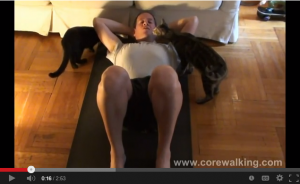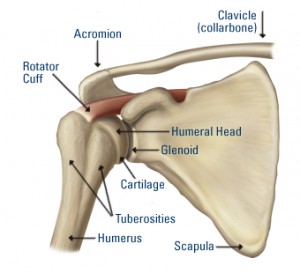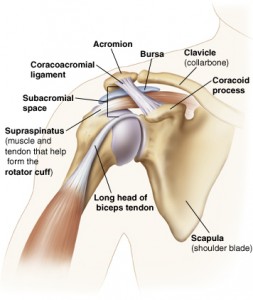 Strengthening the rotator cuff muscles serves everyone whether you have an injury or not.
Strengthening the rotator cuff muscles serves everyone whether you have an injury or not.
The numbers of rotator cuff injuries I encounter are staggering. My wife hurt her rotator cuff in kickboxing months ago and has still not healed.
And every time I hear her wince in pain, whether it is from yoga, putting her jacket on, or putting away groceries, I obnoxiously remind her that every time she feels the injury she is re-injuring it and healing will take that much longer.
The rotator cuff is a fascinating piece of our anatomy.
Four muscles make up the rotator cuff connecting the arm bone (humerus) to the shoulder blade.
In all parts of the body, ligaments are very strong and they connect bones to other bones. To have the ultimate freedom that is available to the human shoulder, the shoulder ligaments are lax by design and the tendons of the rotator cuff provide stability to the shoulder. Among other functions, they hold the head of the humerus into the glenoid fossa of the scapula.
Most rotator cuff injuries occur due to poorly executed repetitive actions.
In my wife’s case, it involved punching without the proper rotation that over time created an impingement that led to the pain.
Many rotator cuff injuries involve the supraspinatus muscle which passes through the coracoacromial arch formed by the acromion process and the coracoid process of the scapula with the coracoacromial ligament spanning between them.
The supraspinatus tendon has to pass through this arch so poor alignment and misuse leads to injury.
I’ll save the relationship of the pelvis and rotator cuff injuries for another post but needless to say I think that the worst thing for the alignment and functional use of the rotator cuff is a chronically tucked pelvis.
You can work on strengthening the rotator cuff forever but if your pelvis is tucked and misaligned you will constantly have poor alignment of the shoulder and rotator cuff muscles.
The muscles in the rotator cuff are:
Teres minor- externally rotates the arm.
Infraspinatus- externally rotates the arm.
Supraspinatus- pulls the arm up and away from the body.
Subscapularis- internally rotates the arm
Injuries to the rotator cuff are fairly easy to diagnose on one hand but there are often corollary issues with the deltoids and the tendon of the long head of the biceps brachii muscle (post coming soon).
The video (thanks to my co-stars Princess and Superkitty) at the top of this post is the best exercise I know for strengthening the rotator cuff and bringing stability to the shoulder joint.
There is a lot going on in this exercise beyond just the rotator cuff muscles, including the legs, and the core, and the all-important rhomboids that play a huge role in shoulder stability and movement. And I want to thank my cats Princess and Superkitty for co-starring in the video.
Strengthen the Rotator Cuff
- Lie down on your back. Bring your arms out to the side with the wrists at the height of the shoulders, like the letter T. Turn your palms up towards the ceiling.
- Draw your knees up into your chest.
- Keeping the shoulders on the ground, bring your knees over towards the right elbow.
- Looking straight up the whole time, keep the legs together and slowly come back up to the center and do the second side.
- Only go as far you can with the shoulder blades grounded into the floor. Don’t go all the way over. It is better to hover the knees off the ground to make the muscles of the rotator cuff and back work.
- Do your best to keep your knees in line and your thighs together.
- If it is easy to go all the way over with the knees bent, straighten the legs and move the toes on an angle towards the fingertips. This should be much more difficult.
- Don’t go all the way over. Even if you can reach the floor with the shoulders down, hover a few inches off the floor to make the work more intense.




